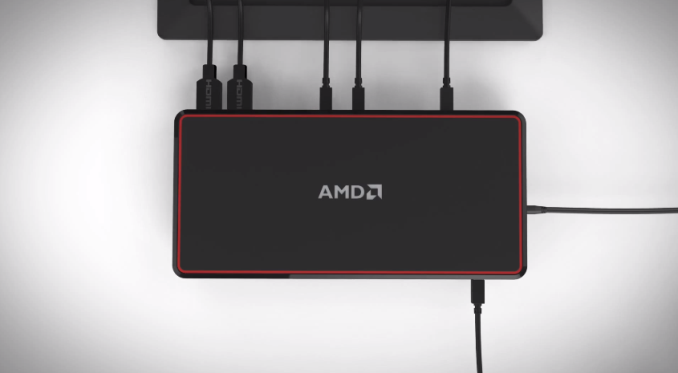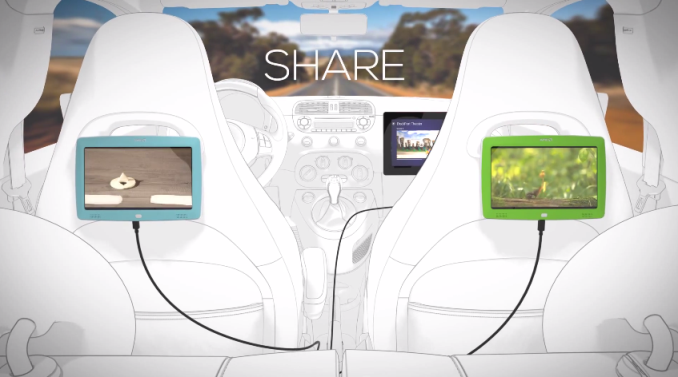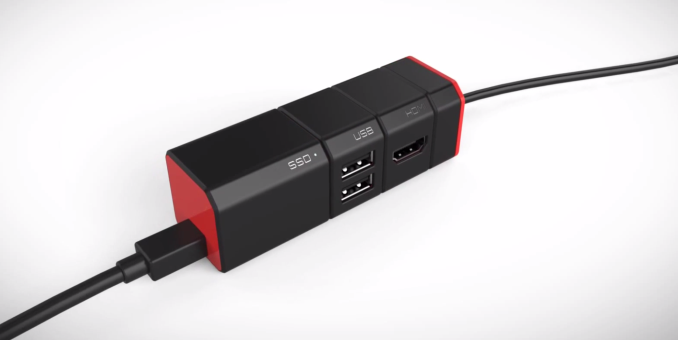AMD’s DockPort Given Virtual Overview
by Ian Cutress on February 13, 2014 4:58 AM EST- Posted in
- AMD
- DisplayPort
- DockPort

Flying somewhat under the radar, DockPort from AMD is designed to be a low-cost all-in-one solution for external connectivity for a PC or tablet. Sound familiar? Like Thunderbolt familiar? This is AMD’s solution to the issue of connectivity, using the DisplayPort connector to transfer USB information as well as audio/visual.
Not a lot has been said about DockPort, despite originally being given a name sometime in 2012, but since CES 2014 has been adopted as an official DisplayPort standard extension by VESA with a finalized standard expected in Q2. With the combination of DisplayPort and USB 3.0 over a single cable, AMD’s video explains it best how it can be used:
To list the possible uses:
- Charging (over USB 3.0 standard we would assume)
- Docking to an external keyboard/battery/audio
- Connecting Storage, Audio outputs, Video outputs, USB hubs
- Share video or run multiple video screens
Basically this is everything USB can do, including video stream via DisplayPort, albeit in a single interface that is already standard across many systems and form factors. AMD have not specified what extra hardware is needed beyond DisplayPort compatibility (presumably the next iteration of the DisplayPort standard) or whether this extension is just for limited use with a bridge chip. DockPort verified cables will be needed, and no idea on the cost of those this early in the development cycle, or whether the standard will be roped into DisplayPort fundamentally. The main competition is of course with Intel's Thunderbolt, where one of the features I am most looking forward to is Graphics over TB. That will not be possible with DockPort, but it will try to do everything else it seems, although it does seem to suggest that DockPort will be limited to USB 3.0 for any data-related daisy chaining, unless AMD have an ace up their sleeve.
I would imagine AMD would tie this technology into their desktop motherboard line, as well as their SoCs, when it is ready which might increase adoption rates faster than Thunderbolt. Having both interfaces use a similar sort of connector asks the question whether the two interfaces might be coherent in the same output/input, making future devices (namely storage) able to use both in one connector rather than have specific DockPort/TB inputs.
This is still early days, given the computer generated nature of AMD’s video. Computex is still several months away – we might see an real world update then. Looking forward to it…!


















52 Comments
View All Comments
piroroadkill - Thursday, February 13, 2014 - link
Yeah, you're wrong. But at the same time, having a USB controller means the end device can be much cheaper and less complicated.Xajel - Thursday, February 13, 2014 - link
There's two things I can see, (1) the reason why Thunderbolt is expensive is because Intel want it to be a premium... and they started it with the exclusive deal with Apple first... I don't think that the chip, socket & cable costs that much... not even close.. they want more profit from it.. not to mention the license fee per device/connector...(2) What If AMD managed later to have a DockPort 2.0 version of it which could have PCIe data also ( the device can choose between PCIe or USB ) ? I think the reason for why they went for USB 3.0 now is to lower the costs for both adopters from the MB sides and the external devices sides.. as both USB 3.0 and DisplayPort are everywhere now and cheap to implement also ( I still hope that future DP standard will add CEC support in order for it to compete HDMI even in consumer electronics )...
repoman27 - Thursday, February 13, 2014 - link
The reason why Thunderbolt is expensive is because it's really at the edge of consumer and bordering on datacenter / HPC technology. It's a 4-channel 10.3125 Gbit/s SerDes that can tunnel multiple protocols and (finally) supports channel-bonding. According to Intel ARK, dual-port Thunderbolt 2 controllers are only $9.95. Compare that to the X540-AT2 dual-port 10GBASE-T Ethernet Controller which costs $149.79 and has a TDP 4.5 times higher. I'd love to know what the Thunderbolt licensing fees actually are, because thus far device pricing has not aligned in any way with the chip prices listed on ARK. Nevertheless, Intel has still managed to lower the cost and power consumption of external serial I/O at those kinds of data rates by an amazing amount.AMD probably could MUX a single PCIe 2.0 lane into DockPort, but it might be a bit more difficult and would likely increase the cost of the controller. DP can theoretically support CEC over the AUX channel.
Morawka - Friday, February 14, 2014 - link
Thunderbolt chips arent that expensive on the Bill of Materials if you take a look at it over at ARK. The new thunderbolt 2.0 is $10 per chip, Thunderbolt 1.0 is even cheaper @ $5 per chip.Problem is, manufacturers are not willing to pass the costs savings to the end user which is slowing adoption rate.
For Example: A dual HDD thunderbolt Enclousure is on newegg right now for $300
2X Thunderbolt 2.0 Chips = $20
Enclousure and wiring= $10
total cost of Bill of materials: $30
Throw in R&D, Marketing, Packaging this adds another $50 AT MOST. so thats $90 total, but they charge $300, raking in around 300% profit
Flunk - Friday, February 14, 2014 - link
For an I/O IC $20 is insane, USB ICs cost less than 1/10th that. You have to remember the full bill of materials includes many different components. No one is going to be enthusiastic about buying a product that isn't any functionally better but costs $18 more.SirKnobsworth - Friday, February 14, 2014 - link
FYI both TB ports are handled by a single controller.repoman27 - Saturday, February 15, 2014 - link
By my reckoning, if your BOM cost exceeds 30% of your retail selling price, you're probably doing it wrong. Don't forget things like testing, certification, licensing, drivers (if required), assembly, shipping, distribution, support, warranty claims, etc. that all erode your margin.That being said, your BOM also has some issues. As SirKnobsworth pointed out, devices only require a single Thunderbolt controller, even if they are dual-port. However, for a typical HDD RAID enclosure, you will need a SATA host controller which will run ~$2-$5. You also need to deal with the DisplayPort output aspect of Thunderbolt. While the newer controllers have made great strides at integrating most of what is required, the original controllers, which many designs are still based on, were sorely lacking. Take a gander at the original LaCie Thunderbolt Little Big Disk: http://images.anandtech.com/galleries/1411/IMG_022... There's something like 30 ICs on that board, and nearly half of them, about $14 worth, are just to handle the DP signal in case someone plugs a display into the thing.
Compare that to the new Thunderbolt 2 version: http://images.anandtech.com/galleries/3296/DSC_466... Things are way less complicated, and since it uses a PCIe SSD, there's no need for a SATA controller. There are however a couple TI TPS22981 Thunderbolt PMICs, which run $1.24 each, a couple 2Mb serial flash modules at $0.56 each, an NXP LPC11E14FHN33/401 ARM Cortex-M0 microcontroller for $1.38, and what I'm guessing is a Parade PS181 DP to Dual-Mode DP format converter for another ~$3.50, although I can't make out the markings in any of the photos I've come across. Plus additional for the passives, PCBs, connectors, heat sink / fan assembly, switch, power supply, cable (if included), etc.
The bottom line is that historically, the premium for single port Thunderbolt devices has started around $80 and for dual-port devices at about $180, which appears to be well beyond what can be justified by the BOM alone. I'm curious to see if prices come down as everything becomes much more tightly integrated, or if OEMs will continue to toe the line. It's hard to say how much of the pricing issue is due to onerous licensing terms from Intel, or just the relatively small potential customer base thus far.
@Flunk - $20 for an I/O IC that provides 4x 10 Gbit/s channels is insanely cheap, and if we believe ARK, it's actually only $9.95. Can you point to any other IC that provides that kind of throughput per $? For applications that can use the bandwidth, it's potentially worth the premium. Unless you're talking about serious RAIDs, Thunderbolt HDD enclosures are almost as silly as USB 3.0 mice.
lmcd - Saturday, February 15, 2014 - link
Hotswapping PCIe SSDs like flashdrives would be pretty awesome, IMO. Could even replace CompactFlash.schizoide - Thursday, February 13, 2014 - link
So I'm confused, this is (somehow) USB3 over a physical displayport connection, which allows daisy-chaining rather than forcing a hub? And you can plug-in to power/charge at the end of the daisy-chain? And it can pass displayport video as well? That is super cool, if it's cheap.Like most people, I've been waiting for a good external thunderbolt PCI-e graphics solution for a long ass time. I want to buy a macbook air, plug in a little $100 box with my own Geforce 760, and get console-level graphics. But for whatever reason, nobody has seen fit to provide such a thing.
TheStu - Thursday, February 13, 2014 - link
The problems are:1. Intel limits that sort of thing. You have to get the thunderbolt controllers from them, and they won't always license them if they don't like what your doing.
2. Power. A 760 needs about 150w of power, which requires a power brick that weighs about as much as the MacBook Air you're hooking it up to.
I've done a lot of research into this, and am trying to develop a cost effective solution, but those are the stumbling blocks.